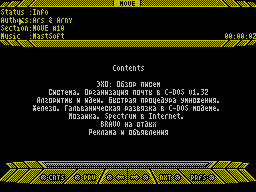|
Move #08
18 июля 1997 |
|
Hackers - The structure of the standard track drive.

HACKER
The structure of the standard track.
When writing information to disk for
modified method of frequency
modulation (MFM) incoming information
is a sequence
bytes, each bit of which encoded
follows. Drive heads in the
the process of recording forms at the track
magnetized point (IP), and
domains are the positive and
negative (different direction
magnetic flux in the drive heads).
Each bit consists of two domains. When
This unit consists of a bit
Negative and positive domain
(-,+); Zero bit following the unit
consists of two negative domain
(-,-); A zero followed by zero in (+,-).
Example: a sequence of bits 1001
schematically represented as follows
as follows: -+,--,+-,-+.
One of the features (MFM) is
that the sequence identical
bits can be read as a
sequence of zeros and a
sequence of units, depending
from the point at which the controller has started its
read. Incorrect reading bits
called a failure of synchronization. The higher
recording density per track, the less
the distance between synchronizing
domains. Besides these information
bytes, the controller writes on track
special bytes, called the marker. These
bytes of information are different from those
that they have a sequence of three
zero bits, the second of which
is written as if in front of him
was one. This is the only
when the track record three
negative domain in a row.
Marker bytes are part of the
targeted markers (AM), which
recorded on the track during her
format and are designed to
indicate the beginning of tracks and sectors.
Each address marker consists of 3
specific marker bytes and bytes
identity marker. Before each
marker recorded Adjustment
sequence of 12 zero bytes,
which is designed for accurate
adjusting the frequency of the internal quartz
generator controller in accordance with
specific frequency domain transmission
synchronization under the head of the drive
(Seizure frequency and phase). Such adjustment
necessary because of the inevitable spread of
values of speed drives and
clock generator frequency controllers.
Beginning (and end) of each track
is the intersection point of the circle
track with a radius passing through the center
index hole disk. In the beginning
track record the sequence of 80
byte # 4E, called GAP4A. (The procedure
formatting from the firmware of their TR-DOS
defined 10, because of what the brake
IBM-ovsky controller does not have time
"Grab" the beginning of the first (the first on
track) sector). Next is the address
marker lanes (IAM), which is required
for the normal operation of the controller. IAM
contains the marker bytes # C2 and
ID # FC. Then comes
sequence of 50 bytes # 4E,
called GAP1 and title or
identifier (ID) of the first sector,
consisting of the address marker header
(IDAM), 4 bytes (TRACK, SID, NUM, LEN),
2 bytes 'CRC' (CRC).
Marker bytes IDAM have a code # A1,
ID # FE. The header of each
sector should be the sequence of the 22
byte # 4E, which is called GAP2
(Intra-period), then
address marker data sector (DATA AM),
Information bytes (content sector)
and two bytes 'CRC'. DATA AM consists of
marker byte # A1 and ID # FB
or # F8. # FB corresponds to normal
data, # F8 - the so-called remote
data, and this division has
purely a formality. Deleted data
read and write exactly the same way as
and normal, just using different
command controller. During the end of the first
sector bytes of intersectional
gap with the code # 4E. Intersectoral
period, with a name GAP3, in
Unlike the above described, has
variable length. Interval from the end
the last sector before the end of the track
called GAP4B. This gap,
filled with bytes # 4E, has a variable
length, and is actually a
blank tire tracks.
Information provided:
Tom_Hial / Ascendancy Cr.L. Grodno
Other articles:
Similar articles:
В этот день... 20 December